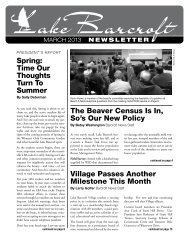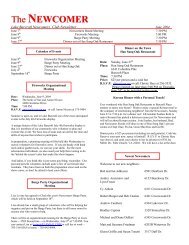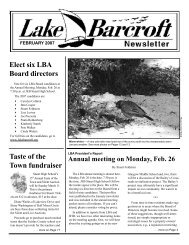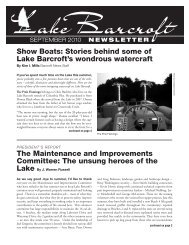Lake Barcroft History Book
Lake Barcroft History Book
Lake Barcroft History Book
Create successful ePaper yourself
Turn your PDF publications into a flip-book with our unique Google optimized e-Paper software.
consulting engineers and the Allis-Chalmers Corporation to<br />
design the Bascule gate and to modify the dam. In July 1973,<br />
as WID funds became available, fabrication of the Bascule<br />
floodgate started at the Allis-Chalmers plant in York,<br />
Pennsylvania. The design called for a 150-foot by 12-foot<br />
hydraulically operated gate that would be able to handle<br />
storms more powerful than Agnes. The workers at the plant<br />
referred to it as “<strong>Lake</strong> <strong>Barcroft</strong>’s Watergate,” and added, “it<br />
won’t leak.” This was a not so subtle reference to the Watergate<br />
scandal that was unfolding at the time, which was marked by<br />
numerous stories leaked to the press. Fabrication of the gate<br />
and modification of the dam required careful planning. To<br />
meet a promise to revive <strong>Lake</strong> <strong>Barcroft</strong> by summer 1974, the<br />
trustees set a target date of April 30 for completion of the<br />
floodgate project. If the work was not completed by then, the<br />
contractor would be penalized $1,000 per day for up to<br />
thirty days.<br />
While committees and individuals worked on various projects,<br />
vegetation was growing on the lake bottom. Several<br />
enterprising residents seized the opportunity to plant<br />
vegetables in the fertile soil, reminiscent of World War II<br />
victory gardens. According to one apocryphal story, two<br />
youngsters, noted for their indolence, exhibited a great deal of<br />
energy in preparing, cultivating and planting their garden in<br />
the lakebed. It was the first sign that the boys were actually<br />
taking an active interest in something so mundane. In the<br />
end, their crop flourished, but alas, the plants turned out to<br />
be marijuana.<br />
In July, the WID trustees leased a Mud Cat dredge to remove<br />
silt from the base of the dam. The operator sucked up the silt<br />
and pumped it to a receiving basin on the lakebed. Tree<br />
stumps, sunken boats and even car parts jammed the sluice<br />
valve. Once workers cleared the sluice, the remaining water<br />
41<br />
drained into the stream below the dam. Work then began to<br />
fill in the washouts at the ends of the dam. The contractor<br />
positioned a custom-made cage over the sluice, thereby<br />
preventing further obstruction. This operation was so<br />
successful that the WID trustees eventually purchased a Mud<br />
Cat for the community and hired an operator to pump silt<br />
into decanting basins.<br />
By mid-August 1973, residents could see visible progress in the<br />
restoration of the washout and the removal of silt from the<br />
lake. These efforts proceeded apace during the summer and<br />
fall. Front-end loaders scooped dry silt into trucks and cleaned<br />
out coves that had been clogged by<br />
the discharge from storm drains.<br />
The contractor worked long hours<br />
to complete the land excavation<br />
before the arrival of freezing<br />
weather. As many as fifty trucks at<br />
a time carted away silt and moved<br />
fill to the earthen sections at the<br />
ends of the dam.<br />
By November of that year, the<br />
washouts were completely restored.<br />
This allowed for partial filling,<br />
which would not interfere with<br />
dam modifications and installation<br />
of the Bascule gate. Even though<br />
the lake’s level was below the<br />
normal water line, it still spawned<br />
visions of winter ice-skating and<br />
summer swimming. This step











